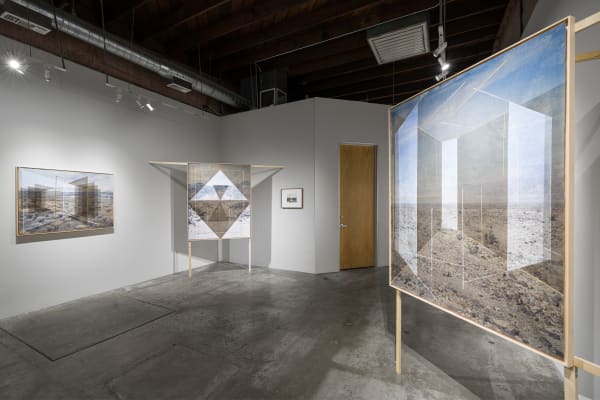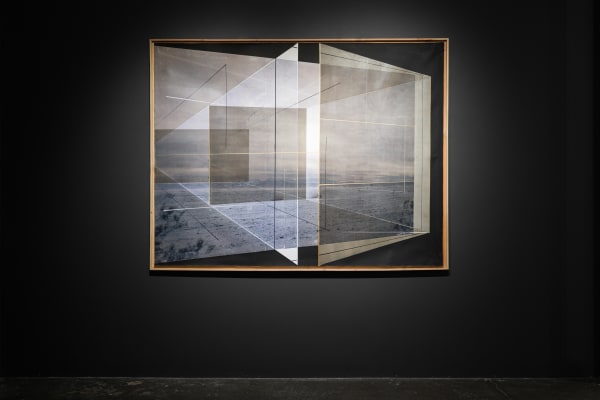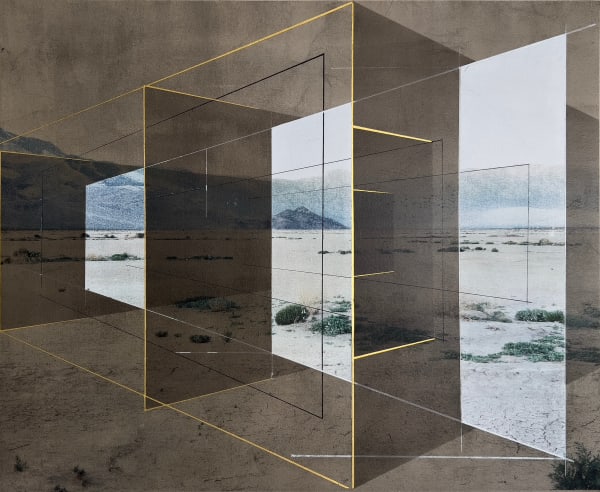LAND/SPACE: Rodrigo Valenzuela & The New Topographics
“The illusory possibility of deep space, full of potential until it clashes with brute reality.”
– Carmen Winant, from the foreword to Rodrigo Valenzuela: Journeyman
Marshall Gallery is pleased to host a summer exhibition anchored by the works of one of LA’s great young artists, Rodrigo Valenzuela, showing recent works from his series New Land. Interspersed among the Valenzuela installation is a selection of vintage photographs from the New Topographics era, primarily from the 1970s and 80s, taking a cross-generational look at the potential energies and implications of land development and space in the American West. Prints are included by artists Robert Adams, Nicholas Nixon, and Henry Wessel, as well as Mark Ruwedel, Minor White, John Szarkowski, and William Garnett. In the gallery’s project room, a selection of Valenzuela’s photography series American Type is also on display. With this juxtaposition, the gallery continues to champion artists expanding the creative potential of photo-based art as its primary curatorial focus while placing them within the perspective of the medium’s historical pendulum.
-
 Rodrigo Valenzuela, Barricades #4, 2017
Rodrigo Valenzuela, Barricades #4, 2017 -
 Rodrigo Valenzuela, New Land, 2024
Rodrigo Valenzuela, New Land, 2024 -
 Rodrigo Valenzuela, New Land, 2024
Rodrigo Valenzuela, New Land, 2024 -
 Rodrigo Valenzuela, New Land, 2024
Rodrigo Valenzuela, New Land, 2024 -
 Rodrigo Valenzuela, New Land C36, 2025
Rodrigo Valenzuela, New Land C36, 2025 -
 Rodrigo Valenzuela, New Land, 2024
Rodrigo Valenzuela, New Land, 2024 -
 Robert Adams, Dead Palms, Partially Uprooted, Ontario, California, 1983
Robert Adams, Dead Palms, Partially Uprooted, Ontario, California, 1983 -
 Robert Adams, Santa Ana Wash, Next to Norton Air Force Base, San Bernadino County, California, 1978
Robert Adams, Santa Ana Wash, Next to Norton Air Force Base, San Bernadino County, California, 1978 -
 Minor White, Two Barns and Shadow, Dansville, NY, 1955
Minor White, Two Barns and Shadow, Dansville, NY, 1955 -
 John Szarkowski, From Country Elevator, Red River Valley, 1957
John Szarkowski, From Country Elevator, Red River Valley, 1957 -
 Henry Wessel, Walapai, AZ, 1971
Henry Wessel, Walapai, AZ, 1971 -
 Nicholas Nixon, Summer Cottage Camp, Chatham, Massachusetts, 1976
Nicholas Nixon, Summer Cottage Camp, Chatham, Massachusetts, 1976 -
 Rodrigo Valenzuela, American-type No. 11, 2018
Rodrigo Valenzuela, American-type No. 11, 2018 -
 Rodrigo Valenzuela, American-type No. 6, 2018
Rodrigo Valenzuela, American-type No. 6, 2018 -
 Rodrigo Valenzuela, American-type No. 4, 2018
Rodrigo Valenzuela, American-type No. 4, 2018
The exhibition LAND/SPACE originated with and is centered around the mixed media works of Chilean artist Rodrigo Valenzuela (b. 1982), an artist who works predominantly through conceptual photography but is equally accomplished in video, installation, and sculptural practices. Upon first view, one encounters floating canvases layered with geometric abstractions over arid landscapes, but as with all of Valenzuela’s projects, themes of labor, immigration, and socio-political hierarchies are at play. The pieces on view, made by a laborious photo-transfer process utilizing toner-based inks and acrylic paint, depict translucent polygons floating, untethered among California deserts. The fields of varying opacities appear like architectural walls of glass in some future modernist architecture or perhaps a holographic land art installation. But upon closer inspection, their façade is faded and scarred as a result of an imperfect interchange of substrates, bearing a rough surface antithetical to the “Finish Fetish” sought by earlier generations of LA artists from the Light and Space movement.
After arriving in the US just over a decade ago as an undocumented immigrant, Valenzuela survived working various arduous construction jobs before his artistic prowess achieved stability in academia and he eventually acquired citizenship. That experience, as well as his upbringing in Santiago with blue-collar, pro-Union parents during the Pinochet dictatorship, led to an engrained sense of civic engagement and an impressive work ethic. The toner inks used in works from New Land are most commonly associated with high-frequency office printers which for the artist is a symbolic nod to the bureaucratic mountain of paperwork, administrative forms, and photocopies that immigrants have to navigate in the pursuit of legal residency.
Along with the architectural sketch implied in the compositions, his ongoing title for the works, New Land, implies an air of hyper-development akin to the signage for master-planned suburban communities in the making. Billboards that float along empty grids of pavement across the US announce “New Homes Coming Soon”. However, Valenzuela portrays the reality of loneliness and isolation that deserts actually elicit, in contrast to spaces for utopian development, spiritual rejuvenation, or in which to escape and manifest one’s destiny. Sharon Mizota puts it in her essay for Valenzuela’s monograph “Journeyman”, that by “depicting the romantic, wide-open spaces of the American West in this dull, systematic way, he puts a damper on their grandeur, emphasizing instead their generic emptiness.” This element of tactical banality echoes aspects of an earlier era of celebrated photography also included in the installation.
Originally curated by William Jenkins as an exhibition at the George Eastman House, New York in 1975 under the same title, New Topographics became an entire genre of post-modern photography in Cold War America that took an objective, non-romanticized look at the realities of America. The movement was stylized, paradoxically, by the anti-style of deadpan photographs depicting anonymous land/spaces, primarily of the rapidly developing, concrete-wrapped American West. Like Valenzuela’s pieces, the photographs are devoid of human figures and instead focus on the tension between nature and (architectural) structures. The latter works as a symbolic stand-in for humans as the culmination of urban expansion with little concern for the pre-existing environment.
While the New Topographics’ subject of choice was “man-altered landscapes”, Valenzuela’s paintings forecast man-altered landscapes-to-be as the unquenchable thirst for expansion and growth advances in a game of chicken with climate change-fueled record temperatures and pervasive drought. But beyond the pictured scene itself, both Valenzuela and the New Topographics photographers were also interested in questioning photography’s role as an allegedly truth-bearing document in our culture. But the “topographers” work is often imbued with irony and detached from the creator’s influence, common to post-modern “art about art”, which Valenzuela’s work exchanges for a recognizable style. His geometric over-painting unapologetically brings back a certain aesthetic beauty and consideration to an otherwise drab and forgettable topography. The artist states, “I always try to mix a bit of hope and a bit of disappointment. This is an important tension for me.”
Rodrigo Valenzuela (b.Santiago, Chile 1982) lives and works in Los Angeles, CA, where he is the Associate Professor and Head of the Photography Department at UCLA. Valenzuela has been awarded the 2021 Guggenheim Fellowship in Photography and Smithsonian Artist Research Fellowship; the Joan Mitchell Award for painters and sculptors; the Art Matters Foundation grant; and the Artist Trust Innovators Award. Recent solo exhibitions include: New Museum, NY; Lisa Kandl-hofer Galerie, Vienna, AU; Jordan Schnitzer Museum of Art, Eugene; Orange County Museum; Portland Art Museum; Frye Art Museum, Seattle. Recent residencies include Core Fellowship at the Museum of Fine Arts, Houston; Skowhegan School of Painting and Sculpture; MacDowell Colony; Bemis Center for Contemporary Arts; Lightwork; and the Center for Photography at Woodstock.


























